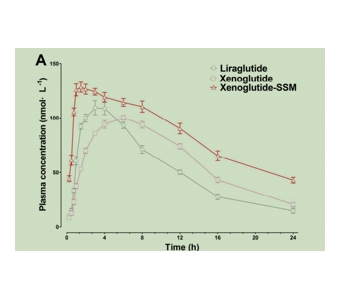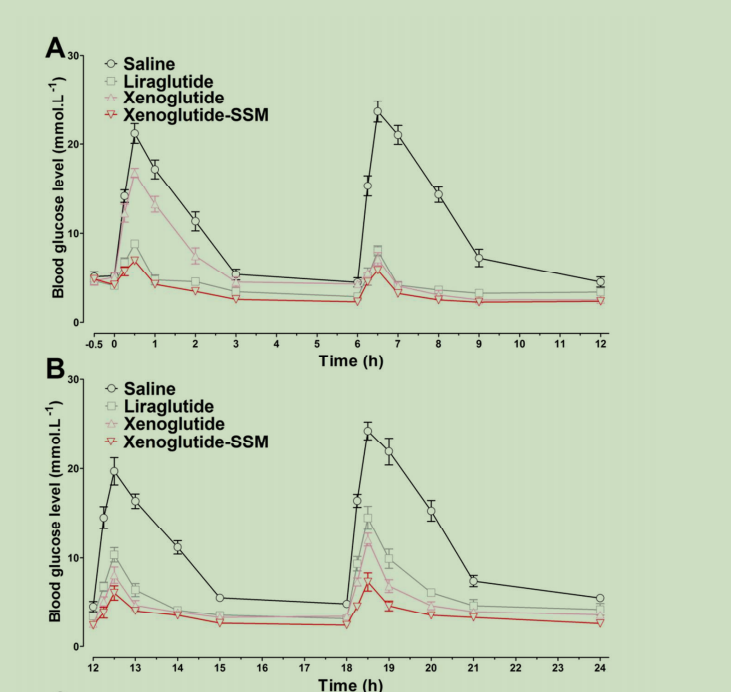文献:Micellar Nanomedicine of Novel Fatty Acid Modified Xenopus Glucagon-Like Peptide-1: Improved Physicochemical Characteristics and Therapeutic Utilities for Type 2 Diabetes
文献链接:https://pubs.acs.org/doi/10.1021/acs.molpharmaceut.7b00632
作者:Jing Han, Yingying Fei, Feng Zhou, Xinyu Chen, Weiwei Zheng, and Junjie Fu
原文摘要:To develop novel long-acting antidiabetics with improved therapeutic efficacy, two glucagon-like peptide-1 (GLP-1) analogs were constructed through the hybridization of key sequences of GLP-1, xenGLP-1B, exendin-4 and lixisenatide. Hybrids 1 and 2 demonstrated enhanced in vitro and in vivo biological activities, and were further site-specifically lipidized at lysine residues to achieve prolonged duration of action and less frequent administration. Compared with their native peptides, compounds 3–6 showed similar in vitro activities but impaired in vivo acute hypoglycemic potencies due to decreased aqueous solubility and retarded absorption in vivo. To circumvent these issues, compound 3 (xenoglutide) was selected to be self-associated with sterically stabilized micelles (SSM). The α-helix and solubility of xenoglutide was significantly improved after self-associated with SSM. Notably, the improved physicochemical characteristics of xenoglutide-SSM led to revival of acute hypoglycemic ability without affecting its long-term glucose-lowering activity. Most importantly, preclinical studies demonstrated improved therapeutic effects and safety of xenoglutide-SSM in diabetic db/db mice. Our work suggests the SSM incorporation as an effective approach to improve the pharmacokinetic and biological properties of hydrophobicity peptide drugs. Furthermore, our data clearly indicate xenoglutide-SSM as a novel nanomedicine for the treatment of type 2 diabetics.
DSPE-PEG2000 是一种具有特定结构和性质的化合物,在纳米颗粒的制备过程中,DSPE-PEG2000 可以作为表面活性剂或稳定剂,防止纳米颗粒聚集和沉淀,提高纳米颗粒的稳定性和分散性。该文献介绍异谷鲁肽xenoglutide通常是一种多肽类物质,具有特定的氨基酸序列。可能具有调节生理功能的作用,例如参与代谢调节、对特定细胞或组织产生作用等,将其作为研究工具,用于研究细胞信号传导、生理过程等。

图为:利拉鲁肽、异种鲁肽和异种鲁肽-SSM在体内的药代动力学特征和厌食作用
DSPE-PEG2000在xenoglutide制备中的应用:
DSPE-PEG2000 末端带有需要活化的功能基团,可以使用适当的活化剂对其进行活化。例如,对于马来酰亚胺基团,可以使用三 (2 - 羧乙基) 膦(TCEP)等还原剂进行活化。将活化后的 DSPE-PEG2000 与异谷肽在适当的条件下进行反应,使 DSPE-PEG2000 与异谷肽通过共价键连接。反应条件可以根据具体的功能基团和反应类型进行调整,如温度、pH 值、反应时间等。反应完成后,需要对修饰后的异谷肽进行纯化,去除未反应的 DSPE-PEG2000、杂质和副产物。可以使用色谱法、透析法等方法进行纯化。将修饰后的xenoglutide与其他材料(如磷脂、胆固醇等)按照一定的比例混合,通过特定的制备方法形成纳米颗粒。DSPE-PEG2000 在纳米颗粒中可以起到稳定颗粒、调节表面性质、增加生物相容性等作用。通过调整制备参数(如温度、搅拌速度、溶剂比例等)和材料组成,可以优化纳米颗粒的粒径、表面电荷、稳定性等性能。DSPE-PEG2000 的含量和性质也可以对纳米颗粒的性能产生影响,需要根据具体情况进行调整。使用各种表征技术对制备的xenoglutide纳米颗粒进行表征,包括粒径分布、表面电荷、形态结构、化合物包封率等。DSPE-PEG2000 的存在可能会影响纳米颗粒的这些性能,因此需要对其进行详细的分析。建立严格的质量控制标准,对制备的xenoglutide纳米颗粒进行质量检测。确保纳米颗粒符合相关的质量要求,如纯度、稳定性、生物相容性等。DSPE-PEG2000 的质量和性能也需要进行检测和控制,以保证纳米颗粒的质量。

图为:通过在db/db小鼠中使用多个OGTT来评估异种鲁肽-SSM的长期降糖作用
结论:DSPE-PEG2000 是一种两亲性聚合物,具有亲水性的 PEG 链和疏水性的 DSPE 部分。在xenoglutide制备过程中,它可以通过疏水相互作用与xenoglutide结合,在其周围形成一层保护膜,防止xenoglutide分子之间的聚集。DSPE-PEG2000 可以使xenoglutide在溶液中更加均匀地分散,减少颗粒的聚集和沉淀。这有助于提高xenoglutide的表征和分析的准确性和可靠性。如果需要对异谷肽进行荧光标记,DSPE-PEG2000 可以增加荧光标记的稳定性,减少荧光淬灭的发生。这使得xenoglutide的荧光标记更加持久,便于进行荧光成像等分析。

 2025-05-26 作者:lkr 来源:
2025-05-26 作者:lkr 来源:

